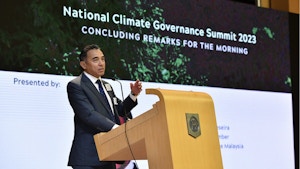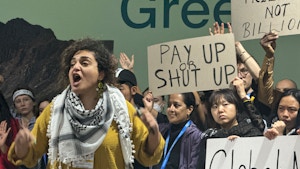Negotiators secured a breakthrough on the first day of the COP29 climate summit by agreeing on rules for a United Nations-administered global carbon market.
To continue reading, subscribe to Eco‑Business.
There's something for everyone. We offer a range of subscription plans.
- Access our stories and receive our Insights Weekly newsletter with the free EB Member plan.
- Unlock unlimited access to our content and archive with EB Circle.
- Publish your content with EB Premium.
Article 6.4, a section under the Paris Agreement which lays out the foundation for countries to trade carbon credits, has been one of the longest-standing disputes at the COP negotiations due to disagreements on the integrity of these rules, or how to ensure any promised emissions reductions are additional and can be easily verified. Last year’s COP28 summit in Dubai failed to deliver a consensus to operationalise the mechanism, despite high hopes of a positive outcome.
Proponents of the global carbon market say the mechanism will advance sustainability goals, as well as funnel billions of dollars into emissions-cutting projects in developing countries.
COP29 president Mukhtar Babayev hailed the decision that came in the final hours of the summit’s opening day as an early win, saying that Article 6-governed carbon markets could reduce the cost of implementing nationally determined contributions (NDCs) by US$250 billion dollars a year.
“This will be a game-changing tool to direct resources to the developing world. Following years of stalemate, the breakthroughs in Baku have now begun. But there is much more to deliver,” Babayev said.
NDCs, or climate action plans that individual nations need to submit to the UN Framework Convention on Climate Change (UNFCCC) detailing how they will reduce greenhouse gas emissions and adapt to the impacts of climate change, are a central part of the Paris Agreement. Governments, under pressure to meet emissions thresholds, believe that carbon trading can help facilitate the removal of emissions at no additional costs.
The fast-tracked route to reaching a consensus on the trade rules, however, has drawn criticism. Civil society groups and legal experts have raised concerns about the lack of a due process, with some calling the urgency to secure an early outcome at COP “risky”.
In a pre-COP meeting in October, the supervisory body responsible for Article 6.4 adopted standards that include requirements for developing and assessing projects that allow countries to trade reductions in carbon emissions, as well as projects that remove greenhouse gases from the atmosphere. Such benchmarks needed direct approval from COP in the past, but this time, the body finalised and adopted the standards under its own supervision.
“This bypasses countries’ ability to revise and strengthen these standards,” said nonprofit 350.org in a statement.
“At COP27 and COP28, governments rejected draft rules on carbon removal, warning that they could weaken climate action and encourage risky approaches like carbon capture and geoengineering. Now, these rules are moving forward without the same scrutiny.”

Attendees mill around the entrance inside the Baku stadium on the first day of COP29. Image: COP29 Azerbaijan via Flickr
Isa Mulder, policy expert on global carbon markets at Carbon Market Watch said adopting the rules on the first day of the summit does not give countries and observers time to debate on such a “highly sensitive and contentious issue” whose text still leaves many unanswered questions.
Mulder cited how the text does not include guidance on how to deal with projects that face reversal risks like storing carbon in a natural sink which might release that carbon after a few years.
“If these texts can be adopted in this way, where do we draw the line? This should not happen again,” she said.
The operationalisation of Article 6.4 marks the full implementation of Article 6 which is seen as crucial for developing states to achieve their low-carbon pledges, experts have said.
Countries seeking to “offset” their climate footprint will help pay for the development of projects that sequester or prevent greenhouse gas emissions like planting trees and protecting forests which generate exchangeable “credits” representing one metric tonne of greenhouse gas emissions each. Poor countries use the funds earned from the sale of carbon credits towards mitigation measures such as renewable energy projects.
But offsetting is not always a clear-cut way for countries to reach their climate goals. Under the mechanism, host countries earn from purchasing carbon credits, but seller countries cannot claim the benefit to avoid “double-counting” or having the benefits counted twice.
Double-counting is one of the issues that will be tackled at the negotiations under Article 6.2, which covers government-to-government carbon credit deals. Despite being operational since COP26, the mechanism is lacking detail on how countries can ensure there is no double counting of emissions reductions through corresponding adjustments.
COP is “only place” for climate action
Earlier in the day, United Nations climate change chief Simon Stiell, in his COP29 opening speech, asserted the continued relevance of the UNFCCC meeting. Industry observes have called into question whether the decades-old negotiation platform can advance real action beyond symbolic agreements, though Stiell did not directly make reference to the criticisms.
“This UNFCCC process is the only place we have to address the rampant climate crisis and to credibly hold each other to account to act on it,” Stiell said. “And we know this process is working, because without it, humanity would be headed towards five degrees of global warming.”
The COP climate summit gathers leaders from around the world every year to discuss solutions to climate change and global warming. It is one of the few international platforms that provide an opportunity to Indigenous people and climate-vulnerable nations to speak across the table with global superpowers
Last year, COP28 attracted over 97,000 people including 2,456 fossil-fuel lobbyists who outnumbered nearly all individual country delegations.

United Nations climate change chief Simon Stiell prepares to give his speech at the opening session of COP29. Image: COP29 Azerbaijan via Flickr
Small developing countries have voiced their disappointments about the COP process. Papua New Guinea said in August that it will be boycotting COP29 as a form of protest against the world’s largest countries, which are also the biggest greenhouse gas emitters. Its prime minister James Marape said the pledges and pronouncements made at COP “seem distant from victims of climate change” as well as countries like itself which hold substantial forests.
Marape is not alone in thinking that rich countries have not paid their fair share of climate finance over the years, despite numerous pledges.
Even as new, larger climate finance targets are being negotiated, some developing nations say they still have not seen the effects of the US$100 billion promised by developed countries nearly a decade ago, at COP21 in Paris. Rich countries claimed to have achieved this target in 2022, although it was meant to have reached poorer countries two years earlier.
COP28 also closed with the historic operationalisation of the loss and damage fund that aims to provide compensation for losses and damages from climate-induced disasters. However the combined total of more than US$700 million pledged to the fund has not increased since then.
This sum is the equivalent of less than 0.2 per cent of the irreversible economic and non-economic losses developing countries are facing from global heating every year.
Stiell said that at the COP convening, “specific pieces of the puzzle” are negotiated each year and “it can feel faraway from” how communities are suffering from climate impacts. “So let’s make it real. Do you want your grocery and energy bills to go up even more? Do you want your country to become economically uncompetitive? Do you really want further global instability? The climate crisis is affecting every single individual in the world, one way or another, and I am as frustrated as anyone that one single COP can’t deliver the full transformation that every nation needs,” he said.
“But if any of your answers to these questions were ‘no’, then it is here at COP that parties need to agree a way out of this mess.”
Stiell, as well as COP29 president Mukhtar Babayev, is anchoring COP29’s success on coming to a consensus on a new global finance goal. He also announced new UNFCCC initiatives on climate engagement, including a “climate plan campaign” that will mobilise action from countries to deliver on their NDCs, as well as restarting “climate weeks” from 2025 to “align them closely with the UNFCCC process and the outcomes it must deliver”.














